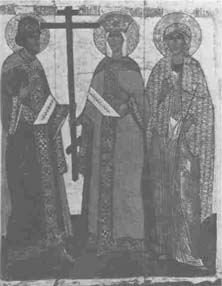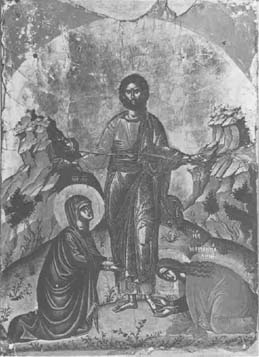
Bulletin 26, 1975
Home
Français
Introduction
History
Annual Index
Author &
Subject
Credits
Contact



"Christ
with Saints Alexandra and Agatha"
A Russian Icon in the National Gallery
by George Galavaris
Pages 1
| 2 | 3
| 4
| 5
| 6
| 7
Like Alexandra, St Agatha is not so popular in eastern Christian
art. According to the account of her life, she was a beautiful
virgin, a member of a noble family from Catania in Sicily who
suffered martyrdom in the time of the emperor Decius (249-251).
She was subjected to various tortures, one of which involved the
removal of her breasts (this was to become one of her attributes in
western European art). Agatha died a frightful death; she was thrown
on burning coals that were mixed with shards. She is commemorated on
5 February, though four other dates in the Church calendar-year are
related to her. In the early Christian period she was one of the
most important martyrs both in the East and in the West, and popniar
imagination was to develop her saintly properties in the form of
various legends concerning her and her miracle-working veil. (13)
Considering the numerous representations of her in western European
art, one can definitely say that she was not popular in eastern
Christian art, either in Byzantine or post-Byzantine times. In the
art of the early Church she is represented like other female martyrs
without any special attribute, as one can see in the sixth-century
mosaics in the nave of the church of S. Apollinare Nuovo, Ravenna.
Her attributes appear in art from the fourteenth-century and only in
the art of the West. Later depictions of her appear in the narthexes
of Byzantine churches, and at times in a bust form within a
medallion as, for instance, in the eleventh-century mosaics of the
catholikon of the monastery of Hosios Lukas in Phocis. (14) She is also
represented with other saints in calendar icons: two such examples
from the twelfth-century are in the monastery of St Catherine on Mt
Sinai. (15) Occasionally one sees depictions of her martyrdom such as
that in the Menologion of Basil II, now in the Vatican (cod. gr. 1613, fol. 373r). (16)
In Russian icon painting her images are rare and continue the
tradition of the standing portrait adopted for representations of
female martyrs. The Tretyakov Gallery catalogue lists only two examples,
two sixteenth- or seventeenth-century icons of the Moscow
school which show Agatha standing on the margin of a larger
composition. She is associated with George, Euphrosyne, Daniel the
Stylite, Theodore Stratilates, and the martyrs Irina and Xenia. (17)
She is similarly depicted in a late nineteenth-century icon. In
this case placed below Theodore Stratilates, she witnesses the
Decapitation of John the Baptist, the main subject of the icon. (18)
In
another Russian icon (dating from the second half of the
seventeenth-century and now in Recklinghausen), which portrays feast
scenes and standing portraits of saints, Agatha is shown with Irina
and other female saints. The figures are not placed around a central
composition but stand next to one another in the manner of pictures
found in menologia ("calendar") icons. (19) There is a
calendar icon with St Agatha, dating from the nineteenth-century,
now in Schloss Autenried. (20)
However, none of the above-mentioned examples has any iconographic
connection with our icon. The master of the National Gallery icon
has taken St Agatha from the margins of her obscurity and has placed
her in a major composition. There is only one work which differs
from those cited above and which relates, somewhat, to the Ottawa
icon in concept, in so far as Agatha has been given an eminent
position. This icon (c. 1500), probably a product of the
circle of Master Dionysius and now in Recklinghausen, portrays
Agatha on the same level with Constantine and Helena (fig. 7). (21) But
even this icon differs fundamentally from ours because it typifies
the tradition of frontally standing saints followed in menologia.
The presentation of these icons has made it clear that there is no
example known to me which parallels the iconography exemplified by
the National Gallery icon. Agatha and Alexandra are not limited to
the margins of larger compositions: the master of our icon has given
these two saints principal roles and has not followed the practice
of depicting "standing portraits" common in seventeenth-
and eighteenth-century Russian icon painting. These features
clearly set the Ottawa icon apart.
The creator of the Ottawa icon has instead sought his prototype in
representations of saints adoring Christ. The ultimate sources of
his composition may be more than one. For instance, one of these may
be a scene - known in Byzantine art since early times - depicting the
appearance of Christ before the myrrh-bearers (Chairete) (Matthew
28: 9-10). A sixteenth-century Greek icon in the Stavroniketa
monastery on Mount Athos representing this theme furnishes us with
an example of a composition that comes very close to that employed
by our master (fig. 8). (22) It should, however, be remembered that
Russian artists had already used and adapted these earlier Byzantine
models, which means that the master of our icon could have found his
prototype within the Russian tradition of icon painting. A good
parallel is provided by a late sixteenth-century panel now in the
Korin collection, Moscow (fig. 9). (23) Fundamentally, the composition
in both icons is similar and both masters have used the same
component parts including the flying, adoring angels as well as the
same text inscribed on the open Gospels.
Leaving aside the identity of the saints (in this Moscow icon we
have two very popular holy persons, St John Chrysostom and St
Nicholas), the apparent differences pertain to the actions of the
adoring figures. One of the bishops offers his book to Christ and
is directly related to Him through Christ's gesture. In the Ottawa
icon Christ does not seem to point to a specific person. There is
also a differentiation in the stance of the two saints: Alexandra is
in an attitude of complete submission while Agatha is imploring,
looking up at Christ. Apart from these minor differences, the
similarities establish a relation between the two panels - possibly
both derive ultimately from the same prototype - and prove that this
type of composition was known in seventeenth-century Russian
painting.
The discussion of the iconography has shown that the master of the
Ottawa icon has used a composition found in representations of
popular saints to depict holy persons who are not often represented,
and that he has departed from the tradition of portraying them as
standing figures. There is no doubt that he has conveyed to these
saints an unusual importance in accordance with the demands of those
who commissioned the panel. They must have had special reasons for
giving such an eminence to Alexandra and Agatha, a question to which
we shall return after we discuss the style and date of the panel.
This Moscow icon, which has provided the best parallel to our icon
from the point of view of composition, has been ascribed to the
latter part of the seventeenth-century and to the school of Yaroslav.
Notwithstanding certain artistic principles which the two icons
have in common (such as the relationship of the component parts to
the picture frame and the aesthetic function of the figure of Christ
which forms the axis of the composition and at the same time
dominates it), the two panels manifest different styles and cannot
be considered products of the same artistic area.
Next Page | master of Ottawa icon
1
| 2 | 3
| 4
| 5
| 6
| 7
Annual Index | Author & Subject | Credits | Contact
This digital collection
was produced under contract to Canada's Digital Collections program,
Industry Canada.
"Digital
Collections Program, Copyright
© National Gallery of
Canada 2001"